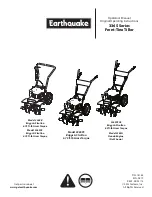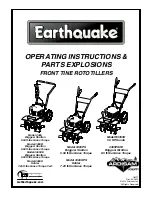
9
Charging or jump starting the battery may
produce explosive gases. Battery gases can
explode causing serious injury.
Keep sparks, flames, or cigarettes away
from battery.
Ventilate when charging or using
battery in an enclosed space.
Make sure venting path of battery is
always open once battery is filled with
acid.
Always shield eyes and face from
battery.
Battery electrolyte contains sulfuric acid,
which is poisonous and can cause severe
burns. Swallowing electrolyte can be fatal
or if it touches skin can cause severe
burns.
Wear safety glasses to shield eyes, and
rubber gloves to protect skin and
clothing when handling electrolyte.
Do Not swallow electrolyte.
In the event of an accident, flush with
water and call a doctor immediately.
If the ignition is in the “ON” position
there is potential for sparks and
engagement of components. Sparks could
cause an explosion or moving parts could
accidentally engage causing personal
injury.
Be sure ignition switch is in the “OFF”
position before charging the battery.
Keep all guards, shields and all safety devices
in place and in safe working condition.
Check all bolts frequently to maintain proper
tightness.
Frequently check for worn or deteriorating
components that could create a hazard.
Removing standard original equipment parts
and accessories may alter the warranty,
traction, and safety of the machine. Failure to
use original Lawn Solutions parts could cause
serious injury or death. Making unauthorized
changes to the engine, fuel or venting system,
may violate EPA and CARB regulations.
Replace all parts including, but not limited to,
tires, belts, chains, tines, and fuel system
components with original Lawn Solution parts.
Hydraulic fluid escaping under pressure can
penetrate skin and cause injury. Fluid
accidentally injected into the skin must be
surgically removed within a few hours by a
doctor familiar with this form of injury or
gangrene may result.
If equipped, make sure all hydraulic fluid
hoses and lines are in good condition and
all hydraulic connections and fittings are
tight before applying pressure to hydraulic
system.
Keep body and hands away from pinhole
leaks or nozzles that eject high pressure
hydraulic fluid.
Use cardboard or paper, not your hands, to
find hydraulic leaks.
Safely relieve all pressure in the hydraulic
system by placing the motion control levers
in neutral, shutting off the engine, and
lowering tines to the ground before
performing any work on the hydraulic
system.
DANGER
DANGER
CAUTION
WARNING
WARNING
Содержание TA3016KAF1
Страница 1: ...Form No 3373 757...
Страница 11: ...11 116 6455 116 6456 116 6457 116 6459 116 6460 116 6461 116 6462...
Страница 33: ...33 NOTES...
Страница 34: ...34...
Страница 36: ......










































